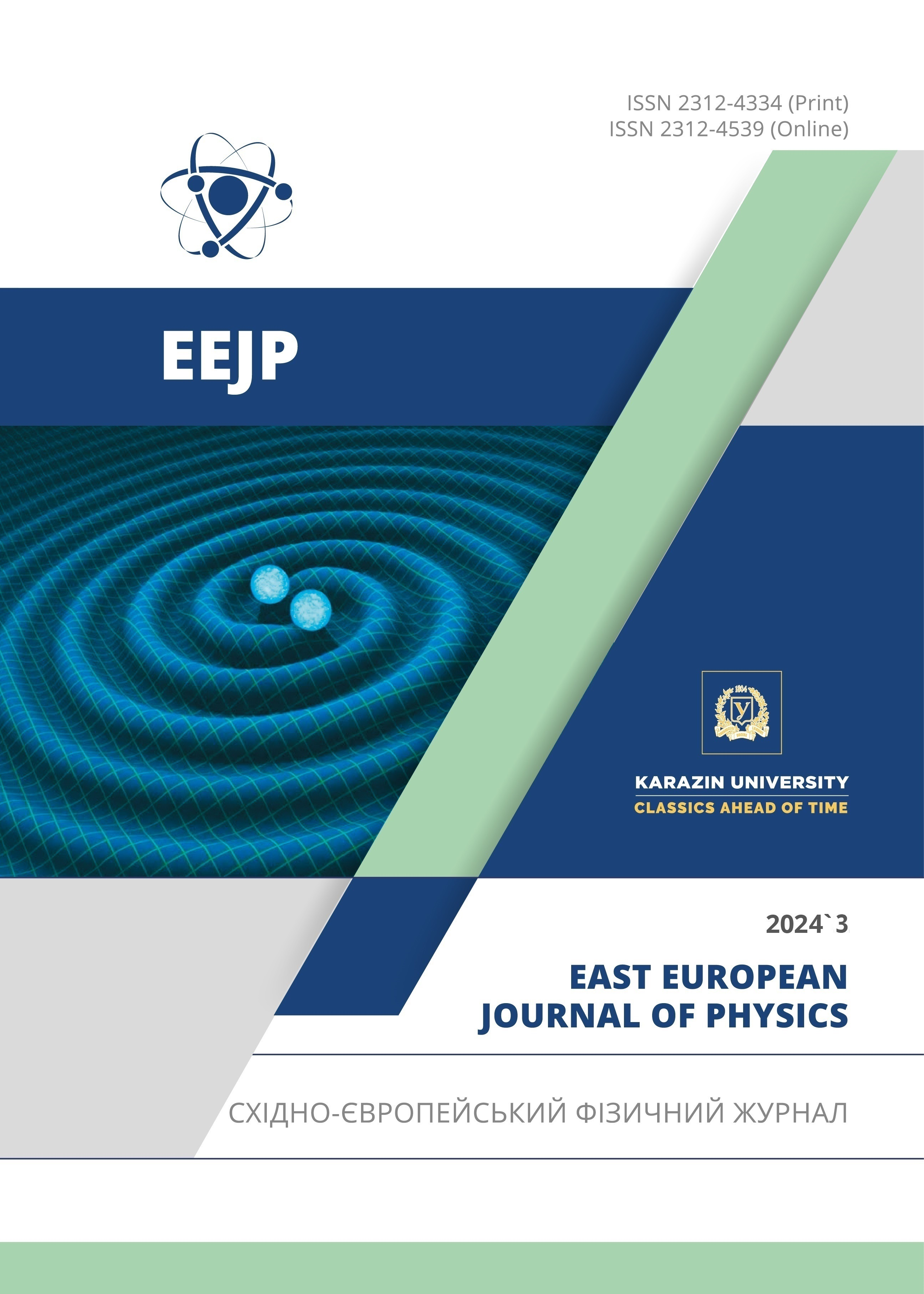Anticipating Pressure Changes in Halides under Compression
Abstract
A new equation of state (NEOS) for Halides has been developed using the theory of lattice potential and the concept of volume dependence of the short-range force constant. The derivation of this equation of state involved the use of the third-order approximation of the lattice potential. A comparative analysis was conducted between the isothermal equations of state, including Vinet EOS, Murnaghan EOS, Holzapfel EOS, Born-Mie EOS, Birch-Murnaghan EOS, and the newly derived NEOS. The NEOS was used to analyze the compression behavior of Halides, and it was found that Vinet EOS and NEOS agreed with the experimental data for Halides up to high compression. However, Murnaghan EOS, Born-Mie EOS, Holzapfel EOS, and Birch-Murnaghan EOS are usually less sensitive to calculating pressure at high compression. It was also observed that for some Halides, such as NaBr and NaI, Vinet EOS could not produce results consistent with experimental findings. In contrast, NEOS consistently produced results that matched the experimental findings for all Halides samples, unequivocally demonstrating its reliability and accuracy.
Downloads
References
C.K. Dixit, S. Srivastava, P. Singh, and A.K. Pandey, Nano-Structures & Nano-Objects, 38, 101121, (2024). https://doi.org/10.1016/j.nanoso.2024.101121
A.K. Pandey, C.K. Dixit, S. Srivastava, P. Singh, and S. Tripathi, National Academy Science Letters, (2023). https://doi.org/10.1007/s40009-023-01358-0
A.G. Davydov, and N.K. Tkachev, J. Phys. Chem. A, 126(23), 3774, (2022). https://doi.org/10.1021/acs.jpca.2c01614
J. Hu, J. Sun, X. Meng, and L.C. Cai, Acta. Physica Sinica, 59(5), 3384 (2010). https://ir.lzu.edu.cn/handle/262010/116974
A. Pandey, S. Srivastava, and C.K. Dixit, Iranian journal of Science, 47, 1877 (2023). https://doi.org/10.1007/s40995-023-01535-2
R.L. Jaiswal, B.K. Pandey, D. Mishra, and H. Fatma, Int. J. Thermodyn. 24, 1 (2021). https://doi.org/10.5541/ijot.869865
P. Singh, B.K. Pandey, S. Mishra, and A.P. Srivastava, Computational Condensed Matter, 35, e00807 (2023). https://doi.org/10.1016/j.cocom.2023.e00807
B.K. Pandey, C.K. Singh, and A.K. Pandey, in: New Ideas Concerning Science and Technology, vol. 13, (2021). pp. 126-131. https://doi.org/10.9734/bpi/nicst/v13/8362D
P.K. Singh, Computational Condensed Matter, 31, e00678 (2022). https://doi.org/10.1016/j.cocom.2022.e00678
R. Gupta, and M. Gupta, Bulletin of Materials Science, 44, 218 (2021). https://doi.org/10.1007/s12034-021-02503-5
S. Srivastava, A.K. Pandey, and C.K. Dixit, Solid State Communication, 377, 115387 (2023). https://doi.org/10.1016/j.ssc.2023.115387
P. Dulari, International Journal of Mathematics and Physics, 10(2), 57 (2019). https://doi.org/10.26577/ijmph-2019-i2-9
F.D. Stacey, and P.M. Davis, Phys. Earth Planet. Inter. 142, 137 (2004). https://doi.org/10.1016/j.pepi.2004.02.003
M. Born, and K. Huang, Dynamical Theory of Crystal Lattices, (Oxford University Press, New York, 1954).
J. Shanker, and S. Dixit, Phys. Status Solidi (a), 123, 17 (1991). https://doi.org/10.1002/pssa.2211230102
J. Shanker, S.S. Kushwah, and P. Kumar, Physica B: Condensed Matter, 239, 337 (1997). https://doi.org/10.1016/S0921-4526(97)00349-9
O.L. Anderson, J. Geophys. Res. 75, 2719 (1970). https://doi.org/10.1029/JB075i014p02719
B. J. Brennan, F.D. Stacey, J. Geophys. Res. 84, 5535 (1979). https://doi.org/10.1029/JB084iB10p05535
A. O L, Equation of State of Solids for Geophysics and Ceramic Science, (Oxford Univ. Press, New York, 1995).
B.W. Dodson, Phys. Rev. B, 35(6), 2619 (1987). https://doi.org/10.1103/PhysRevB.35.2619
F. Birch, J. Geophys. Res. 57(2), 227 (1952). https://doi.org/10.1029/JZ057i002p00227
J. Hama, K. Suito, and N. Kawakami, Phys. Rev. B, 39(5), 3351 (1989). https://doi.org/10.1103/PhysRevB.39.3351
M. Kumar, and S.S. Bedi, Journal of Physics and Chemistry of Solids, 57(1), 133 (1996). https://doi.org/10.1016/0022-3697(95)00150-6
J.H. Rose, J.R. Smith, and J. Ferrante, Phys. Rev. B, 28(4), 1835 (1983). https://doi.org/10.1103/PhysRevB.28.1835
O.L. Anderson, J. Phys. Chem. Solids, 58(2), 335 (1997). https://doi.org/10.1016/S0022-3697(96)00115-1
A.V. Singh, J.C. Sharma, and J. Shanker, Phys. B, 94(3), 331 (1978). https://doi.org/10.1016/0378-4363(78)90039-6
Y. Sato-Sorensen, J. Geophys. Res. 88(B4), 3543 (1983). https://doi.org/10.1029/JB088iB04p03543
Q. Liu, and Z.M. Niu, Int. J. Thermophys. 33, 2267 (2012). https://doi.org/10.1007/s10765-012-1288-8
K. Kholiya, J. Chandra, and S. Verma, The Scientific World Journal, 2014, 289353 (2014). http://dx.doi.org/10.1155/2014/289353
P.K. Singh, Indian Journal of Pure and Applied Physics, 48, 403 (2010).
M.A. Mohammed, and H.B. Mohammed, Advances in Condensed Matter Physics, 2023, 9518475 (2023). https://doi.org/10.1155/2023/9518475
R.W. Roberts, and C.S. Smith, J. Phys. Chem. Solids, 31, 619 (1970). https://doi.org/10.1016/0022-3697(70)90196-4
C.S. Smith, and L.S. Cain, J. Phys. Chem. Solids, 36, 205 (1975). https://doi.org/10.1016/0022-3697(75)90010-4
S.N. Vaidya, and G.C. Kennedy, J. Phys. Chem. Solids, 32, 951 (1971). https://doi.org/10.1016/S0022-3697(71)80340-2
Y.Sato-Sorensen, J. Geophys. Res. 88, 3543 (1983). https://doi.org/10.1029/JB088iB04p03543
Copyright (c) 2024 Abhay Prakash Srivastava, Brijesh Kumar Pandey, Mukesh Upadhyaya

This work is licensed under a Creative Commons Attribution 4.0 International License.
Authors who publish with this journal agree to the following terms:
- Authors retain copyright and grant the journal right of first publication with the work simultaneously licensed under a Creative Commons Attribution License that allows others to share the work with an acknowledgment of the work's authorship and initial publication in this journal.
- Authors are able to enter into separate, additional contractual arrangements for the non-exclusive distribution of the journal's published version of the work (e.g., post it to an institutional repository or publish it in a book), with an acknowledgment of its initial publication in this journal.
- Authors are permitted and encouraged to post their work online (e.g., in institutional repositories or on their website) prior to and during the submission process, as it can lead to productive exchanges, as well as earlier and greater citation of published work (See The Effect of Open Access).








